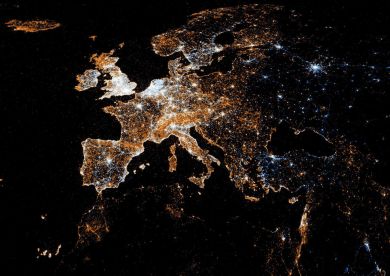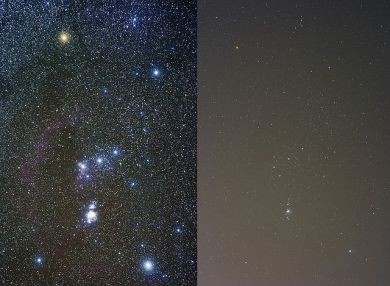The Consequences of Light Pollution

In the previous week's article we explained the concept of Light Pollution. Today, as promised, we are going to address the consequences it has on humans, wildlife and our planet.
The excess light we introduce into our environments harms our ecosystems, especially with regard to the life cycles of animals, which depend on darkness. We are putting ourselves at risk by altering our biochemical rhythms that naturally flow through natural light levels.
Consequences on Human Beings
Human beings, like plants and wildlife, are regulated by circadian rhythms, which are made up of the physical, mental and behavioral changes that occur in a 24-hour cycle.
The circadian clock regulates physiological activities such as brain wave patterns, hormone production and cellular regulation. These rhythms respond to the light and darkness around an organism. Disruption of these rhythms can result in a variety of health problems such as sleep disorders, anxiety, depression, diabetes, cancer, cardiovascular disease, immune disorders and obesity.
Melatonin, the hormone that regulates the sleep cycle, is severely affected by light pollution, as it is activated by darkness and suppressed by light. A melatonin deficiency can result in anxiety and mood disorders, insomnia, hormonal imbalances.
Consequences in the Wild
Light pollution affects the feeding, sleeping, mating and migration cycles of all wild animals. Wild animals can also suffer from disorientation when there is too much artificial light at night.
The excess light we introduce into our environments harms our ecosystems, especially with regard to the life cycles of animals, which depend on darkness. We are putting ourselves at risk by altering our biochemical rhythms that naturally flow through natural light levels.
Consequences on Human Beings
Human beings, like plants and wildlife, are regulated by circadian rhythms, which are made up of the physical, mental and behavioral changes that occur in a 24-hour cycle.
The circadian clock regulates physiological activities such as brain wave patterns, hormone production and cellular regulation. These rhythms respond to the light and darkness around an organism. Disruption of these rhythms can result in a variety of health problems such as sleep disorders, anxiety, depression, diabetes, cancer, cardiovascular disease, immune disorders and obesity.
Melatonin, the hormone that regulates the sleep cycle, is severely affected by light pollution, as it is activated by darkness and suppressed by light. A melatonin deficiency can result in anxiety and mood disorders, insomnia, hormonal imbalances.
Consequences in the Wild
Light pollution affects the feeding, sleeping, mating and migration cycles of all wild animals. Wild animals can also suffer from disorientation when there is too much artificial light at night.
- Mammals - bats, raccoons, coyotes, deer and moose have a hard time looking for food at night due to too much lighting. Additionally, they are also at risk of exposure to natural predators and increased mortality. Excessive lighting at night also causes a decrease in reproduction, which leads to a decline in the aging population.
- Birds - Owls and hawks are nocturnal animals, which use moonlight and starlight to hunt and migrate at night. Artificial light sources can cause birds to be attracted or fixated on artificial lights, deviating from their intended migration route, flying to exhaustion and collapse. Seabirds such as albatrosses are known to crash into lighthouses, wind turbines and drilling rigs at sea due to their bright lights. In North America alone, 100 million birds die annually in collisions with lighted buildings and towers.
- Amphibians - toads, frogs and salamanders in swamps are affected by the fog of excess light confuses and disorients them, which causes a decrease in feeding and mating.
- Reptiles - Sea turtles are extremely affected by light pollution, as females like to nest on remote, dark beaches. However, bright coastal lights prevent them from finding safe nesting areas for their eggs, which causes female turtles to lay their eggs in an unsafe area or in the ocean. On the other hand, newborn sea turtles instinctively crawl towards the brightest part of the beach, which for many centuries was moonlight and the starry ocean. However, excessive artificial lighting confuses the offspring and they end up moving away from the ocean, which can be hunted by predators, run over by vehicles, drowned in swimming pools or die of dehydration or exhaustion.
Environmental Consequences
The International Dark-Sky Association (IDA), a non-profit organization that aims to raise awareness of light pollution, estimates that excessive nighttime lighting releases more than 12 million tons of carbon dioxide each year. An estimated 702 million trees would be needed to absorb the carbon dioxide produced by all this wasted light.
On the other hand, according to a 2010 study by the National Oceanic and Atmospheric Association, photopollution increases air pollution by suppressing nitrate, a form of nitrogen oxide, which cleans the air at night. This process, which prevents emissions from turning into smog, only occurs at night because sunlight destroys nitrate. However, artificial lights from buildings, cars and streetlamps, while incredibly dimmer than sunlight, also affect nitrate and slow down the air cleaning process by 7%.
Energetic Consequences
Excess light wasted daily results in wasted energy. A 2007 IDA study estimated that 30% of all light emitted by outdoor public lighting is wasted. That equates to about 3.6 million tons of coal per year and 12.9 million barrels of oil per year.
It is therefore estimated that the total amount of energy wasted each year due to excessive lighting would be enough to light over 11 million homes and power 777,000 cars.
